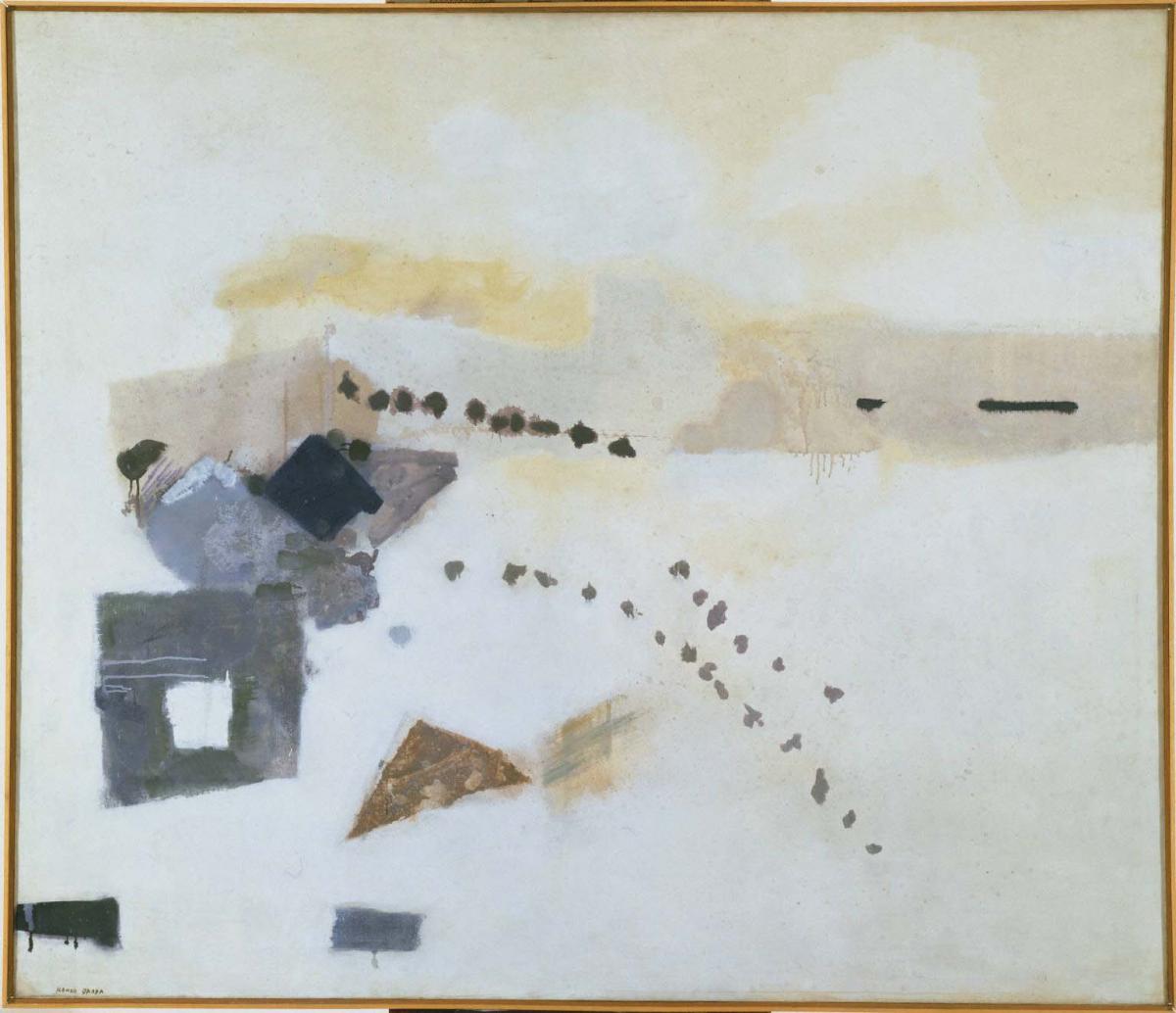Footsteps
Kenzo Okada ( 1954 )

Footsteps was painted in 1952, two years after the painter Kenzo Okada emigrated from Japan to the United States and took up residence in New York City. Stifled by what he referred to as “rigid” forms of tradition, Okada viewed the still-developing art landscape of the Americas as a place where he could forge his own artistic style and path. In his own words, Okada was in search of “a freedom in which I could freely express myself [and] the only place that such a liberty could be found, I felt, would be in the United States, a country that was still very young.”[1]
Inspired by the dynamism of the Abstract Expressionist movement, Okada’s work took on new life. Figuration was replaced by abstract compositions, many of which were drawn from a meditative process he termed “yugenism” from the Japanese word yugen, meaning cryptic, occult, or mysterious.[2] Here, Okada was attempting to attain a kind of “doing without knowing”[3] in his painting practice.
In Footsteps, a trail of dark gray and black stones descends toward the right side of the canvas. Geometric shapes form what could be a homestead or a community of houses. Drips that hang from the bottom of the forms result from the artist turning the canvas, allowing the paint to run in different directions.[4] Museum founder Duncan Phillips first saw Okada’s painting in a 1954 exhibition at the Corcoran Gallery of Art and noted that he “was very much tempted by the beautiful white [Okada].”[5] Two years later he acquired it, and Footsteps became the first work by Okada to enter the collection. It was joined shortly thereafter by Number 2, painted the same year.
Text by Camille Brown as part of the Seeing U.S. Research Project
[1] Stephen S. Prokopoff, Kenzo Okada: A Retrospective of the American Years, 1950–1982 (Iowa City: University of Iowa Museum of Art, 2000), 5.
[2] Gordon Bailey Washburn and Asahi Shinbunsha, Kenzo Okada: Paintings, 1952–1965 (Tokyo: Asahi-Shimbun Press, 1967),
[3] Stephen S. Prokopoff, Kenzo Okada, 9.
[4] Footsteps, conservation report, 1991. Phillips Collection Archives.
[5] Footsteps, object entry, The Phillips Collection website, https://www.phillipscollection.org/collection/footsteps, accessed December 8, 2023.
Okada was an accomplished artist and teacher in the Western figurative tradition when, in 1950, he left his homeland and immigrated to New York. Within three years, according to Gordon Washburn, he had transformed his "European landscapes and...pale French girls" into lyrical abstractions, and had developed a new style representative of a "hybrid flower, a creation whose materials and format are Western and whose inspiration is Eastern." Living in the West gave him the freedom to explore and express his feelings about Japan. As Okada recollected, "When I lived in Japan, I thought only of the West, and now that I am here I dream only of Japan." His dreams became the inspiration for his abstract paintings, and Footsteps, painted in 1954, represents one of Okada's early forays into this new realm of expression.
Okada revealed his Asian heritage through the calm simplicity of the composition, the soft, muted palette, and the subtle allusions to nature. By balancing void against condensed weight, he realized the oriental pictorial tradition of implying vast and ambiguous space. He balanced this by keeping with the concerns of his fellow Abstract Expressionists in America, drawing on imagery from his subconscious, allowing it to dictate his creative hand. He held no preconceived imagery for a picture, but preferred "doing without knowing," in the spirit of Zen Buddhism, which emphasizes meditation.
In Footsteps, Okada’s ambiguous scattered shapes could suggest pebbles, rocks and stocks, and the geometric clusters suggest houses. Okada’s art had a tendency to suggest landscape, as well as the presence of man, balancing human and earth elements. Okada achieved texture in Footsteps by scraping back paint, painting wet-into-wet, splattering paint onto a dry surface, and using a dry brush. He also rotated the canvas as he worked, as evidenced by drips of paint running in different directions. The composition is built up with thin oil washes and the canvas is covered with thin scumbles and glazes.
Duncan and Marjorie Phillips first selected works by Okada for their collection in 1954. After seeing Footsteps at the Corcoran, Phillips was "very much tempted by the beautiful white [Okada]," but chose to wait before pursuing it. Footsteps was again exhibited at the Corcoran in fall 1955, on which occasion Okada visited Washington. Phillips purchased it a year later. He frequently hung it with works by Bradley Walker Tomlin and Mark Rothko in the conviction that Okada shared similar poetic impulses with them.